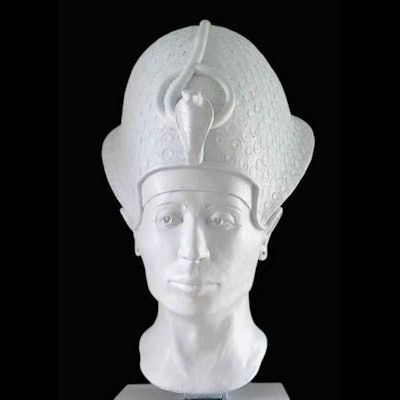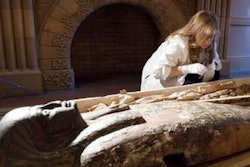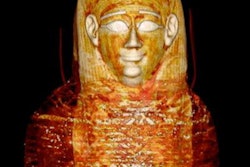
CT software has generated detailed images that allow accurate facial reconstruction of two of Egypt's most famous mummies: Tutankhamun and Ramesses II.
The project, which ran this year to commemorate the centenary of the discovery of Tutankhamun's tomb and the bicentenary of the birth of Egyptology, was part of ongoing work led by Dr. Sahar Saleem, professor of radiology and head of radiology at Cairo University and CT mummy imaging specialist.
She used the latest versions of Dragonfly and Osiris software for reconstructing CT images for both mummies from earlier CT scans to allow experts to digitally and physically re-create the faces of these two celebrated pharaohs from the New Kingdom (1539-1075 B.C.).
 Facial reconstruction of King Ramesses II based on CT shows how he would have looked at 45 (top) and at the age of 90 (bottom) when he died. Images courtesy of Face Lab at Liverpool John Moores University, U.K.
Facial reconstruction of King Ramesses II based on CT shows how he would have looked at 45 (top) and at the age of 90 (bottom) when he died. Images courtesy of Face Lab at Liverpool John Moores University, U.K.Powerful segmentation tools correctly labeled the facial features and distinguished between various materials related to the mummy's face; for example, embalming material placed inside the skull or beneath the skin to beautify the face, Saleem told AuntMinnieEurope.com.
"The software identifies the properties of the various layers of materials on the mummy's face, such as overlying linen bandages, and allows for the digital unwrapping of the pharaohs. The visualization of fine facial features such as ear piercings and hairstyle was also made possible by modern image reconstruction software," she said.
Because of the sophisticated volume rendering capabilities and ability of the software and modern computers to handle large datasets, the new software did much more with old scans than ever before, she added.
How it all began
The journey began with the 0.6 mm CT slices from Saleem's original scans of the mummies taken between 2005 and 2009. Through postprocessing functions such as image enhancement filtering and volume registration, modern image reconstruction software provided detailed insight into the morphology of the mummies' faces.
 A sagittal 2D-CT image of Ramesses II's head shows his prominent high nasal bone, as well as a small animal bone and black pepper seeds placed by the embalmers inside the nasal cavity to preserve the shape of the nose. Image courtesy of Dr. Sahar Saleem.
A sagittal 2D-CT image of Ramesses II's head shows his prominent high nasal bone, as well as a small animal bone and black pepper seeds placed by the embalmers inside the nasal cavity to preserve the shape of the nose. Image courtesy of Dr. Sahar Saleem.To facially reconstruct King Tut, Saleem, who has CT scanned more than 40 royal mummies and helped design the display in the Royal Mummies Gallery at the National Museum of Egyptian Civilization (NMEC) in Cairo, worked in collaboration with Canadian Western University anthropologist Prof. Andrew Nelson and Canadian sculptor Christian Corbet.
The group deployed a deep learning module to recognize the bony skull and differentiate between bone and any embalming material placed on the surface of -- or inside -- the skull. This advanced technology enabled Nelson to define the skull bone and produce an accurate 3D mesh of the skull which was digitally printed in an eight-hour process. Corbet then added facial muscle layers using Egyptian measurements, and gradually built the face physically on the 3D-printed skull.
Three attempts were made in 2005 by Egyptian, French, and U.S. researchers to reconstruct Tutankhamun's face. However, the results of these attempts which used German and U.S. facial measurements were not satisfactory to the scientific community, according to Saleem.
"The most scientific approach is to use measurements from a population that is as close as possible to your subject -- which is what we did," she said. "Different populations and ethnicities have different average measurements in various regions of the face including the slant of the forehead, and the nasal, malar, and labial regions. Facial muscle measurements also differ between different populations and ethnicities, so I advocated the use of Egyptian facial muscle thicknesses from existing tables of data."
However, while the quantitative measurements of the skull and muscle thicknesses created a base for Corbet to work from, Saleem initially queried the resulting aquiline nose, thin lips, and thick eyebrows in the early stage of the reconstruction.
 Dr. Sahar Saleem with busts of King Tutankhamun. The artistic facial bust on the right was sculpted onto the 3D-printed CT skull of his mummy, revealing how Tut would have looked when alive.
Dr. Sahar Saleem with busts of King Tutankhamun. The artistic facial bust on the right was sculpted onto the 3D-printed CT skull of his mummy, revealing how Tut would have looked when alive."The qualitative features cannot be known based on the skull alone. However, the preserved soft tissues of the mummy can help us. Corbet first gave the forensic bust the basic facial features of Tut. However, with my knowledge of Tut's actual mummy and appearance in CT images, I thought that the nose could be shortened and the lips thickened to fit more with the Egyptian look," Saleem said.
The results were documented in a two-part series produced by Soura Films for PBS, Tutankhamun: Allies and Enemies, first aired on 23 November 2022 in celebration of the 100-year anniversary of the opening of Tutankhamun's tomb.
Ramesses II
For the facial reconstruction of Ramesses the Great, Saleem worked with Prof. Caroline Wilkinson, a forensic anthropologist at Liverpool John Moores University, U.K.
Ramesses II's CT scan revealed his facial bone features, including his high pronounced nasal bone and strong jawline. Saleem created a digital 3D CT model of the mummy's head and skull, which Wilkinson then used to build the King's face using computer software designed for criminal investigations. Wilkinson created the facial muscles on the King's skull by observing their attachment marks on the facial bones. Meanwhile, Saleem provided morphometric features such as a brown skin tone, and wavy henna-dyed hair of 6 cm in length.
Ramesses II's digital facial reconstruction was designed to make him look 90 years old. Wilkinson used an age-regression technique to reconstruct Ramesses II's face at the age of 45, when he was at the peak of his military prowess.
This digital facial reconstruction was documented in an episode of Roots and wings (Des Racines & Des Ailes) first aired on 28 September 2022 on France 3 in celebration of the 200-year anniversary of the birth of Egyptology.
Reconstruction results
The reconstructions of the two pharaohs had very different results. While Ramesses was digitally reconstructed with phenotype specificities such as skin tone and hair texture based on archaeological evidence and the mummy itself, as well as in versions of the younger and older pharaoh, the reconstruction of Tut resulted in a classic white artistic bust, which would allow the observer to imagine what he would look like in the flesh, according to Saleem.
 Adding facial muscles to the 3D-printed CT skull of Tutankhamun during the reconstruction process. Courtesy of Soura Films for PBS and Christian Corbet.
Adding facial muscles to the 3D-printed CT skull of Tutankhamun during the reconstruction process. Courtesy of Soura Films for PBS and Christian Corbet.Since the discovery of Tutankhamun's tomb, the majority of the focus has been on the 5,000 plus fantastic and golden objects contained within it, but not much in terms of Tutankhamun, the human being, according to Saleem.
"Putting a face on King Tut's mummy will humanize him and create a bond between our world and his, as well as restore its legacy. King Ramesses II was a great warrior who ruled Egypt for 66 years and initiated the world's first treaty. Bringing Ramesses' face to life in his old age and as a young man reminds the world of his legendary status," she said.
Earlier this year, Saleem revealed the face of King Amenhotep I for the first time in 3000 years in 2022 by digitally unwrapping the mummy using CT technology. Archaeology Magazine ranked this as the world's number one most exciting archaeological discovery in 2022 and will feature the project on the front cover of its January 2023 issue. Amenhotep I has not yet undergone a scientific facial reconstruction, but Saleem hopes this may happen in the near future.



















